Final report for GNC17-246
Project Information
Transforming urban vacant land for agriculture production has been on the rise since the 1890s. Cities that have experienced economic decline that results in an overabundance of vacant land, such as Cleveland, OH, are continuing the trend of urban agriculture. Currently, Cleveland has over 20,000 vacant lots and 235 of these sites have been converted to urban farms and community gardens which address worldwide issues of food security.
However, as urban farmers try to address food security issues, they are faced with the decline in beneficial insects species, such as native lady beetles. These species are needed for the success of agriculture. Since the 1980s researchers have noticed a decline in native lady species which correlates with the introduction of exotic species. The majority of research focused on native lady beetle decline has centered around direct competition, intraguild predation, by exotic species however, if has not been proven in field studies. Exploitative competition, competition for shared resources, is another form of competition that can explain native species decline but it is highly understudied. This form of competition suggest that when exotic lady beetle species reduce a prey base, native lady beetle species will abandon a habitat to forage elsewhere. This implies that the surrounding landscape is likely to affect the supply of beneficial insects. Therefore, I propose to test exploitative competition between native and exotic lady beetle species in order to understand how the composition and management of vacant land influences these dietary interactions among native and exotic lady beetles. My project aims to utilize next generation sequencing tools to: 1)Examine how local habitat management and large-scale landscape composition influences lady beetle abundance and diversity within vacant lots and urban agroecosystems, and 2) measure the dietary breadth and overlap among lady beetle species within vacant lots and urban farms to determine if resource partitioning predicts species diversity within a habitat and how these habitats vary in their ability to support native lady beetle conservation. In short term, my project will contribute to research on conservation of native lady beetle in urban areas. Long term, my project will inform urban farmers and city land managers on the best ways to revitalize urban green space to benefit native lady beetle species that in turn can provide success in urban farms. This will provide economic success in urban cities which can support healthier urban environments and encourage productive urban agriculture.
The long-term goal for my research is to demonstrate if competition with exotic lady beetles explains the decline of native lady beetle species and use this information to design urban habitats to support native lady beetle communities and the biological control they provide to urban agriculture. By the end of the project, urban farmers and Cleveland officials will learn (1) what species of native and exotic lady beetles are found in urban greenspaces and agroecosystems, 2) if competition for food among native and exotic species results in native species declines, and 3) what is the prey diet of the most abundant lady beetle found within Cleveland. A key action outcome will be a factsheet detailing how urban farmers and land managers can take action to conserve native species and their ecosystem services by modifying existing habitats to provide needed alternative prey and other necessary resources.
To distribute knowledge regarding learning and action outcomes I will produce an extension fact sheet and publish a peer-reviewed scientific publication educating readers on the importance of native lady beetles and what can be done to increase their presence. I will also educate owners of urban farms about land management that can be incorporated in their farms to promote an increase in native lady beetle species which in return can promote success in their farms.
Research
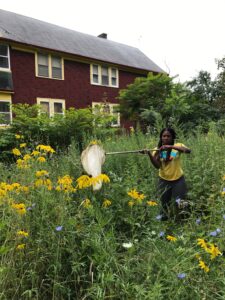
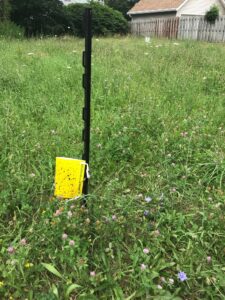
Abundance and Richness
- Lady beetles were sampled within 32 sites throughout Cuyahago County and surrounding counties within Cleveland, OH USA. Four habitats were sampled (8 replicates): Control, High-Diversity Prairie, Urban-Garden and Rural-Farms. Control sites consisted of a turf grass and mown once per month. High-Diversity Prairie sites consist of sixteen native prairie forbs and four prairie grasses. Both Rural-Farms and Urban-Farms produced a variety of fruits and vegetables following organic practices.
- Prior to data collection, we established a 7 m x 10 m within the center of each site. The plot was divided into 1m2 quadrats, and all vegetation and lady beetle data were collected from within this grid.
- Monthly sampling took place during June - August 2018 and 2019
- Lady beetles were collected using no-bait yellow sticky card traps. Five traps were deployed in each site, with one trap placed in each corner of the 7 x 10 meter plot, and one located in the center. The cards were attached to stakes at vegetation height, and remained in the field for 7 days, after which they were brought into the laboratory and identified to species along with aphid prey.
Landscape analysis
- Cleveland City Planning Commission provided us with satellite imagery at 1 m resolution for sites within Cuyahoga County. Landscape categories included: buildings, roads/railroads, grass/trees and shrubs, tree canopy, and water.
- All sites outside of Cuyahoga County are currently being hand digitized and categorizes included: grassland, forest, agriculture, buildings, roads, and water.
Molecular work
- Within each site, 10-20 exotic lady beetles (Propylea quatuordecimpunctata) were hand-collected using aspirator, vacuum, and/or sweep net
- All samples were rinsed in 10% bleach solution, then individually placed in ethanol and stored in freezer until analysis began.
- DNA extractions were carried out using Qiagen DNeasy Blood and Tissue Kit
- Sample were sent to Ohio State University Molecular and Cellular Imaging Center where Next Generation Illumina Sequencing was carried out
- Bioinformatics were carried out to identify prey within the guts of each sample
Analysis:
Below we report preliminary findings. Analysis was carried out using generalized linear mixed models (GLMMs). This analysis evaluates if exotic and native lady beetle abundance differ across Vacant Lots and Urban Gardens within Cleveland, OH. Secondly, we report a list of lady beetle species that were collected within this study. Lastly, we report how surrounding landscape composition influence lady beetle communities.
Lady Beetle Abundance and Community Composition:
- A total of 841 native and exotic lady beetles were collected via yellow sticky traps from Vacant Lots and Urban Gardens within Cleveland, OH
-
Exotic species dominated lady beetle communities, representing 63% of all lady beetles captured.
-
The alien species Propylea quatuordecimpunctata L. was the most abundant lady beetle captured across each treatment representing 54% of all collected individuals.
- The native species Brachiacantha ursina was the most abundant native species captured representing 15% of total lady beetles captured.
-
The second most abundant native species captured was the Coleomegilla maculata (Degeer) representing 16% of the total lady beetle community.
-
Partial Least Squares Canonical Analysis (PLSCA) and relevance network analysis was used to examine how local vegetation and surrounding landscape composition and configuration at 500 and 1500 m influenced the abundance and richness of exotic and native lady beetles
- Findings showed that surrounding landscape had a strong influence on native and exotic lady beetle species composition in Vacant Lots and Urban Gardens
- native and exotic lady beetles found within vacant lots were more abundant in sites surrounding by increased portions of greenspace at the 500 m landscape scale
- native and exotic lady beetle found within Urban Gardens were more abundant in sites surrounded by decreased portion of greenspace at the 500 m landscape scale
Species
Vacant Lot
Urban Garden
Origin
Primary diet
Brachiacantha ursina (Fabricius)
153
10
native
Aphidoidea, Coccoidea
Hyperaspis undulata (Say)
2
1
native
Coccoidea
Coccinella septempunctata (Linnaeus)
0
0
exotic
Aphidoidea
Coleomegilla maculata (Degeer)
23
81
native
Aphidoidea, Pollen
Cycloneda munda (Say)
19
6
native
Aphidoidea
Harmonia axyridis (Pallas)
32
42
exotic
Aphidoidea
Hippodamia parenthesis (Say)
0
0
native
Aphidoidea
Hippodamia variegata (Goeze)
1
0
exotic
Aphidoidea
Propylea quatuordecimpunctata(Linnaeus)
305
149
exotic
Aphidoidea
Psyllobora vigintimaculata (Say)
11
9
native
Fungi (Erisyphaceae)
546
298
GLM results showed that native and lady beetle abundance during 2018 and 2019 were significantly different in vacant lots compared to urban farms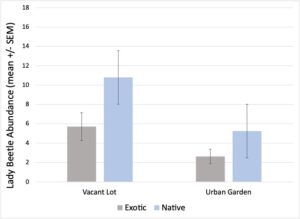 Exotic Lady Beetle Diet Analysis:
Exotic Lady Beetle Diet Analysis:
- 198 Propylea quatuordecimpunctata were collected from vacant lots within Cleveland (10-20) per site
- All data was sequenced using Next Generation Illumina Sequencing
- Bioinformatics is completed and we are undergoing analysis
Future Work:
-
In the future, we plan to complete a non-metric multidimensional scaled analysis (NMDS) which evaluates if lady beetle community composition is unique within each treatments.
-
Prey frequency will be determined based on DNA sequencing results. From there we will analyze whether dietary breadth and overlap differed across treatments.
Educational & Outreach Activities
Participation Summary:
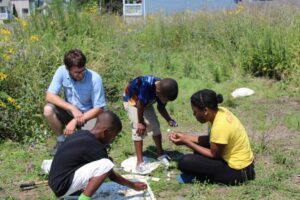
2018: I collaborated with Cleveland's Green Corps of youth farmers to develop a workshop on insect biodiversity in urban farms. During this workshop we constructed different stations that included; 1) learning insect taxonomy, 2) learning how to pin insects, 3) learning how to collect insects, and finally 4) a scavenger hunt that aided in teaching how to identify common plants and insects that occur in urban farms. Involved in this outreach event were Katie Turo (another NCR SARE recipient) and our two mentored undergraduates, who helped design our workshop stations.
I also traveled to Innsbruck, Austria to learn how to do molecular techniques in order to gain skills in determining dietary niche breadth and overlap in urban farms and vacant lots in Cleveland.
2019: We collaborated with the Cleveland Museum of Natural History to host a day long tour of vacant lots, pocket prairies and urban gardens within Cleveland - “From Blight to Bright: Reimagining vacant land to support people and biodiversity in cities“. We rented a bus and brought ~50 participants on a tour of our sites throughout Cleveland. At each site, we discussed research findings that the Gardiner Laboratory has yielded over the past 5 years and their importance.The tour then concluded at the museum with four seminar presentations about 1) urban conservation, 2) Summer Sprout gardening initiatives, 3) the process of prairie construction, and the 4) value of urban trees.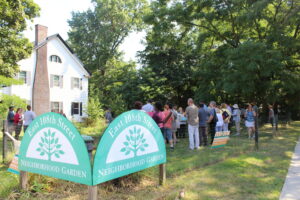
2020: Due to conference coronavirus cancellations, we have not presented research results in person to-date. However, I participated in The Ohio State University College of Food and Agriculture Science Poster Competition and won 2nd place presenting my preliminary findings.
Project Outcomes
As beneficial predators of aphids, scales, and other crop and landscape pests, lady beetles are an important contributor to biological control in agroecosystems. However, natural enemies face unique stressors within cities including pollution and habitat isolation typically not found within rural agricultural landscapes. Assessing how these challenges influence the recruitment, retention, and dietary breadth of natural enemies is necessary to ensure the sustainability of local urban crop production. This project shows how stressors within urban environments effect lady beetles. This research demonstrates if competition with exotic lady beetles, habitats type, or surrounding landscape explains the decline of native lady beetle species and use this information to design urban habitats to support native lady beetle communities and the biological control they provide to urban agriculture sustainability. To this end, my project has contributed to future sustainability by helping farmers decide on the best placements for future farms throughout cities. We have also been able to communicate to urban farmers what species of native and exotic lady beetles are found in urban greenspaces and agroecosystems and are still analyzing if competition for food among native and exotic species results in native species declines.
Personal Knowledge Gained:
Beginning this project I was not aware of the intense amount of work that goes into sustainable agriculture. I was able to see first hand how farmers distributed their produce through farmer's markets and roadside stands with the help of the residents within the community. Seeing this on a more personal level helped me to be able to better relate the scientific work that I do with the needs of urban farmers. It was also amazing to see teenagers within the community learn the importance of sustainable agriculture at a much younger age than me. These teenagers, with the help of the farm managers, were responsible for planting and maintaining the crops. This experience has led to realizing that sustainable agriculture is so much more than addressing food insecurity in a suitable way. It also contributes to urban development and addresses environmental, economic, and social concerns prevalent within inner cities.